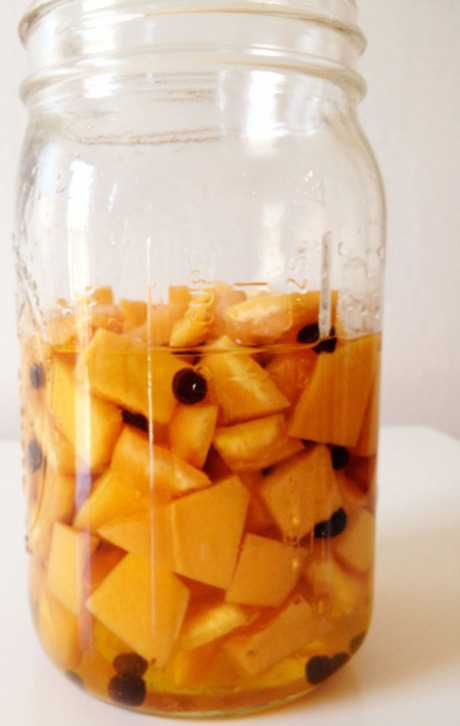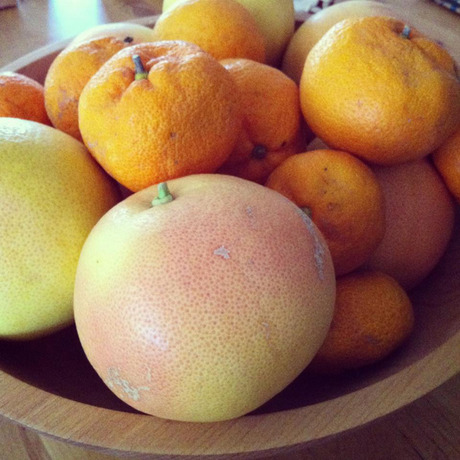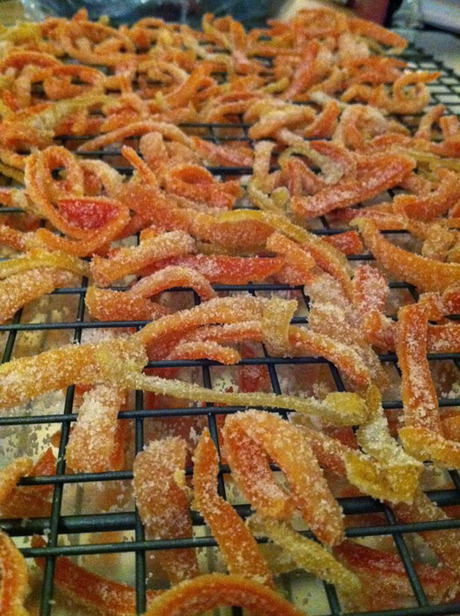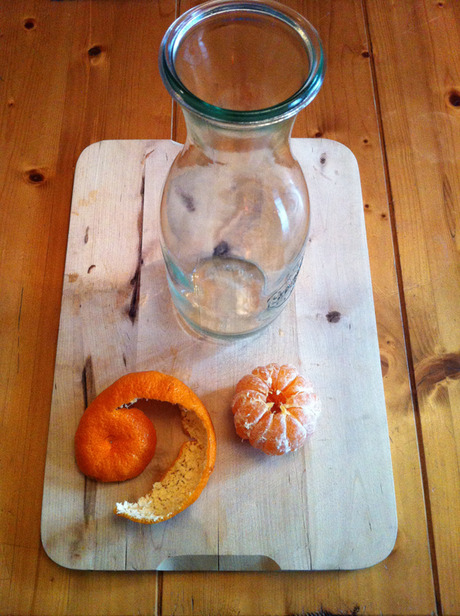I face this problem every year when winter rolls around, what to do with that mound of fragrant peels? Marmalade is great because it sucks the peels into the project. But how much marmalade can one really make? (I make about 3 or 4 batches every winter!)
Chances are you’ve probably also wondered how to use your peels without composting/pitcthing them. I put out the word to see how people are using up their peels and received a ton of brilliant ideas. Thanks everyone who chimed in on Facebook or on Instagram!
Here are a few ideas from the collective hip homies squad, plus, visit Local Kitchen’s post earlier this year for her fabulous and thorough round-up with links to recipes and methods.
I will mention that it’s best to use organic citrus in applications where you anticipate eating or drinking the result. Pesticides aggregate in the peel. I understand it’s not always possible to get organic, so if necessary I’d relegate the non-organics to homemade cleaner purposes, where they’ll get fermented or sit in vinegar for a long time. As always, just do your best to be aware of the inputs when coming up with new outputs!
Boozy things
- Make some sort of -imoncello. I have a recipe for Meyer limoncello, which you can modify to use other peels or find a recipe that suits you. Or maybe infuse small amounts of sipping alcohol, like gin or vodka or whiskey, with peels.
- Make a cordial like Vin de Pamplemousse, this recipe from Local Kitchen is high on my list to try
- Make bitters, like Autumn’s take on grapefruit bitters
- Make sangria by adding chopped up rinds to wine along with cloves and any other fruit
 image courtesy of Autumn Giles, Autumn Makes & Does
image courtesy of Autumn Giles, Autumn Makes & Does
Confections & Cooking
- Candy them. I followed David Lebovitz’s recipe in Ready for Dessert, but there are doubtless zillions of recipes out there to be found. Dipping the candied peels in chocolate makes for an excellent dessert in itself.
- Skip candying and just remove the pith, slice thinly and dip in melted chocolate
- Make a citrus extract, which is just like making bitters, but used instead as an addition to baking and other desserts
- Dry them and stash them for tea, or grind dried peels for use in sauces, marinades, baking or cooking where you want some citrus zing
- Mince peels and toss them in with sea salt and let dry in a 150-200 degree oven for a few hours and you have citrus salt to use on anything, sub sugar for salt and you have citrus sugar
- Zest and freeze the zest for future use
- Make citrus pectin to add to future sweet preserves, like What Julia Ate
- Dice them up and them into sauteed broccoli or cauliflower
- {reader comment addition}Candy the whole fruit, peel and all. A take on candied clementines from Thyme on My Side blogger
- {reader comment addition}Make a lemon peel or orange peel confit. Kelly makes lemon confit by simply covering thinly sliced peels with olive oil and simmering slowly until they are very soft. She keeps them in a container in the fridge and use for everything from making beurre blanc for fish or adding to grain salads or tossing with roasted potatoes, salt, and fresh oregano. She makes orange peel confit by simmering the peels with simple syrup until it gets slightly thickened and amber coloured, and also keeps it in the fridge for use chopped finely in florentine recipes.
- Slice a single, thin-skinned peel into long strips and place in a pitcher of filtered water for a few hours in the fridge. Refill the pitcher using a single peel for up to 24 hours.
Cleaning Products and Household Use
- Simmer in water on the stove, when you are home and not sleeping, of course (or set peels directly on or in a heat-safe bowl of water on your radiator). Refresh the water weekly. Another reader suggested adding peels to a small pot of water and add cinnamon, vanilla, nutmeg and a dash of cloves. Bring to a boil and then simmer on low heat. It makes your apartment smell like fall/Christmas!
- Use dried citrus peels as a base for homemade potpourri
- Exfoliate! Add ground dried zest or thin peels and add into a sugar scrub with lavender essential oil and grapeseed oil for dry winter skin. Another reader makes an extract (see note in the section above) from lemon peels and adds it to make a lemon and honey body scrub.
- Infuse them in distilled white vinegar and use the infusion for cleaning. I prefer to keep my apple cider vinegar for edible uses, but if you have a lot on hand and want to use it to clean, go ahead! One reader mentioned she freezes stashes of thicker peels until she has enough to fill a large jar, then she pours distilled white vinegar over to cover and lets it sit for about a month—it makes an extremely potent cleaner, laundry brightener, etc.
- Take a citrus-infused vinegar cleaner up a notch by adding tea tree oil and have a kickbutt antimicrobial cleaner
- Freeze them, then grind in a food processor or coffee grinder and add to fire ant piles
- Throw them in the garden as a natural pest repellent (and eventual compost)
- Make dryer sachets with dehydrated peels and bits of cinnamon and other spices—just sew the top of a muslin tea sachet or make a little cotton bag and toss in the dryer with your wet laundry; it lasts several weeks to a month.
- Garbage disposal them, one reader’s grandma used to put tiny pieces in the garbage disposal whenever she would run it and it would make the sink smell fresh
- One reader suggested string them together with kitchen twine and drape them around the base of your Christmas tree to keep the cat from climbing it
- Make an enzymatic cleaner (see below)
My friend Sima has been experimenting with this and loving the cleaner she ended up with. Here’s her method:
Ingredients
Citrus peels, enough to nearly fill a 2-quart container
Filtered water
2 Tbs brown sugar (or 2 Tbs activated yeast)
Method
Use a plastic bottle (2-quart sized) and pack with citrus peels (lemon, lime, grapefruit, orange, etc.) leaving a 2-inch space to allow for gas expansion and then fill with water.
Add activated yeast (takes 30 days) or brown sugar (takes 45-60 days), depending on how patient you are in waiting for a cleaning product.
Shake daily for the first couple of weeks making sure to tighten the cap when shaking and then re-loosen the cap when finished. If the gas build-up is not allowed daily release it could blow up. When researching the making of citrus enzyme some folks recommended adding 1 cup of ACV (apple cider vinegar). I have not found this necessary if I wait until the peels are well fermented.
I like to write the date made on the bottle to help keep track of due date. Upon due date strain into jars, keeps for up to 6 months unrefrigerated. Run the post-fermented peels through the garbage disposal (if applicable) when you’re finished.
(Information gleaned from ecokaren.com and happyhomemaker88.com)
Once you make it, use your cleaner for all sorts of jobs. Here are Sima’s (and her inspiration’s) suggestions for dilution and usage:
Undiluted: additions to dishes and laundry by the 1/4 cup, stains on colored fabrics, odors, insect repellant and eliminating fire ants
1 part enzyme: 2 parts water: skincare, either a facial cleanser or toner
1 part enzyme: 10 parts water: clean vegetables and fruit
1 part enzyme: 20 parts water: mopping floors, plant fertilizer, car wash, washing windows.



